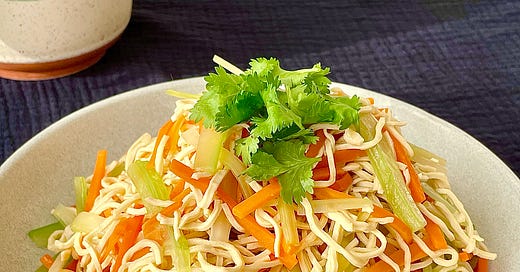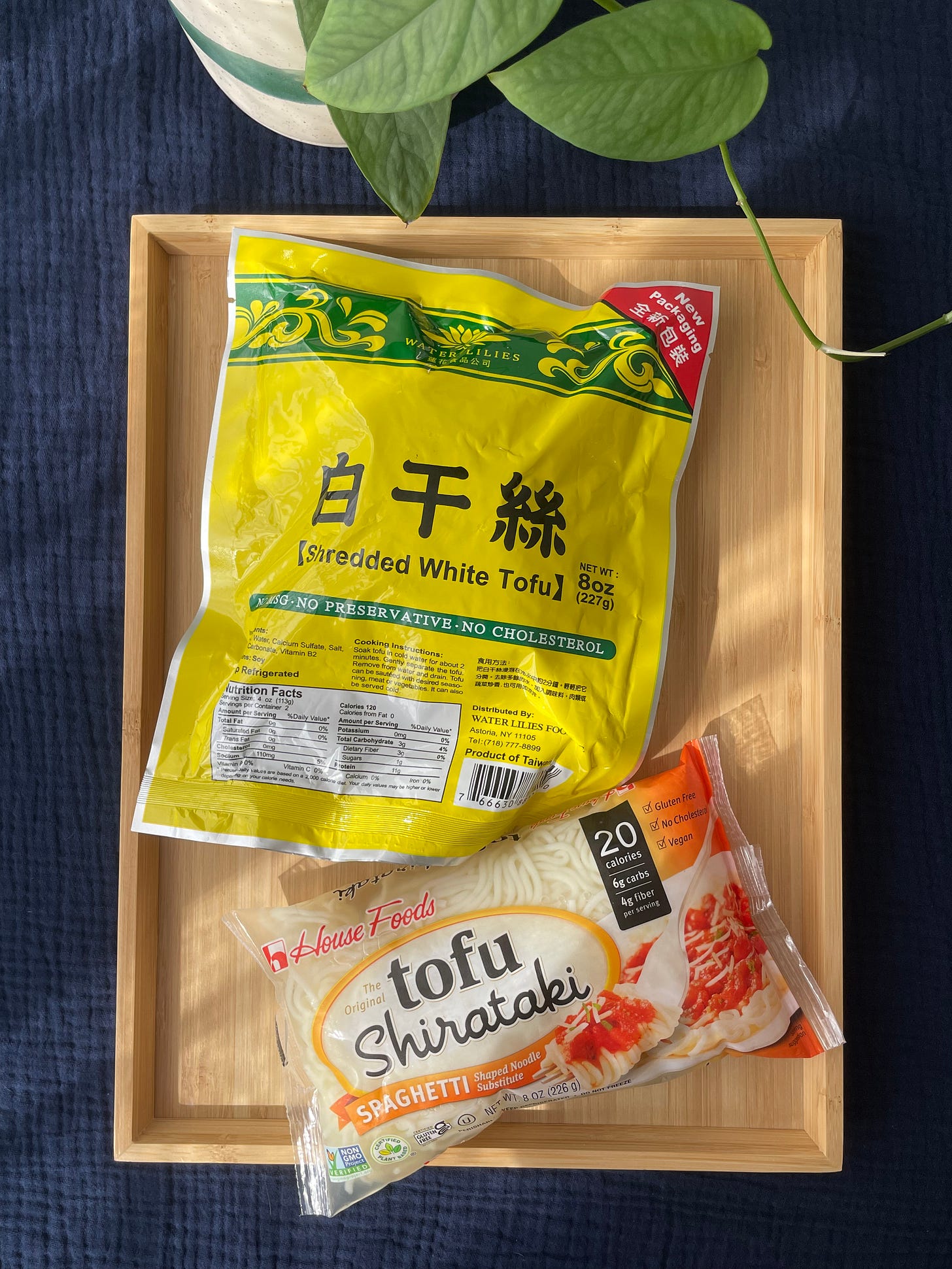Tofu noodle salad 涼拌乾絲
This week we're back to another savory dish that's so good straight out of the fridge
My husband’s Korean American, thus I’ve really embraced the Korean concept of banchans: side dishes such as kimchi and bean sprouts that are offered to the entire table as a part of a meal in Korean restaurants. They can be refilled too, if you ask nicely.
I attribute my love of banchans to my love of hsiao-tsai (side dishes, 小菜) in Taiwanese noodle shops or dumpling shops. Unlike banchan, they’re self-serve, and you pay à la carte. Or if you’re at a fine-dining Chinese or Taiwanese restaurant, the server brings them on a tray along with tea. Wherever hsiao-tsais are offered, they don’t cost much, taste delicious, and balance out any carby noodles or dumplings nicely. Some shops boast impressive selections of wood ear fungus, cucumbers, seaweed, cold cuts of braised pork ears, etc, giving you maximum flexibility to construct a meal by mixing and matching. Given this format, it’s really easy to dine solo at these places in Taiwan: beef noodle soup, some tofu noodles and cucumber salad make a lovely dinner for one. As a genre of food, I can happily see myself making a bunch of hsiao-tsai during meal prep to have all week long. They can be taken them out of the fridge and serve cold, perfect for the summer months. They tend to be easy to make as well, which is good news to me who can eat them by the bucket loads.
The hsiao-tsai recipe I’m sharing today: tofu noodle salad, or gansi (干絲) for short, is something I gravitate towards when I’m eating out or cooking at home. The ingredients list is short: bouncy and chewy tofu noodles, crunchy carrots and celery, nutty sesame oil, some salt, and just a touch of garlic. It is a simple recipe that I’ve made time and time and again and this is a version that I am happy to leave alone and share with everyone. The hardest part of the recipe is probably cutting the carrots, but definitely feel free to use grated carrots straight from the bag, they’d work just fine.
Given the recent trend of low-carb and keto diets, tofu noodles can be a great substitute for carb-heavy noodles, and it’s an ingredient that I wish can become more mainstream. If it’s difficult to access an Asian supermarket for you, I’ve also tried a version with Shirataki noodles, which are made of tofu and konjac root, available in major grocery chains where they have tofu and wonton skins.
INGREDIENTS
1 package (8oz) of tofu noodles or 2 packages (8oz) of shirataki noodles 1
2 thin carrots, peeled and cut into thin match sticks
2 ribs of celery, cut into thin match sticks
1/2 tsp baking soda (optional)
1 small garlic clove, passed through a garlic press
1/2 tsp kosher salt, and more to salt the pot of water
1 tbsp sesame oil
DIRECTIONS:
Blanch the veggies: blanch carrots and celery separately in a pot of lightly salted water just until the rawness is removed (doesn’t take long, try not to overcook). Drain well in a colander2, keep the water in the pot.
Blanch the tofu noodles: Add baking soda3 (if using) to the same pot and blanch tofu noodles until soft, a short few minutes. Look for a slightly bouncy texture that is neither chewy nor mushy. Drain well in the same colander.
Mix everything together: Break noodles into shorter strands if they’re long. Add in salt4, minced garlic and mix thoroughly. Add in sesame oil and mix well. Chill for at least 1 hour in the fridge before serving.
To serve: This dish is served cold as a side dish along with other sides such as seaweed salad and cucumber salad.
Different brands of tofu noodles (also called bean curd noodles or shredded tofu) vary significantly in texture and quality. I use ones from Water Lilies Brand, a Taiwanese manufacturer, available at my local Chinese grocery store and on Weee! (other options here and here). Their noodles have excellent elasticity and great texture. Bonus points for not breaking easily during mixing.
Shocking vegetables in ice water can retain too much moisture. Removing veggies as soon as there is no more rawness reduces this step. It also keeps this dish dry.
Adding baking soda to the cooking water soften tofu noodles faster.
Seasoning can be adjusted to taste. Note that there is no vinegar in this dish. Sugar is optional and can be added at the ratio of 1:2 sugar to salt.







Just got back to EU after living in Taiwan for 6 months. Already started missing the side dishes provided at my university lunches like crazy. Thank you so much for this recipe! Huge help!